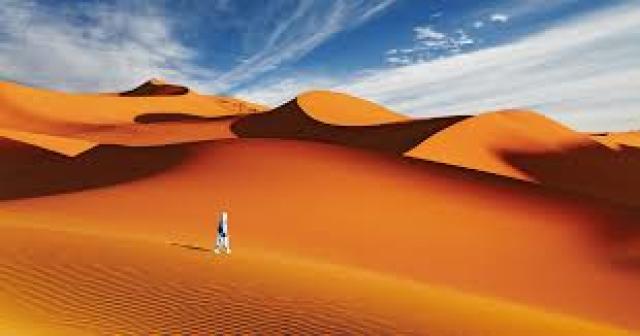The desert comprises much of North Africa, excluding the fertile region on the Mediterranean Sea coast, the Atlas Mountains of the Maghreb, and the Nile Valley in Egypt and Sudan. It stretches from the Red Sea in the east and the Mediterranean in the north to the Atlantic Ocean in the west, where the landscape gradually changes from desert to coastal plains. To the south, it is bounded by the Sahel, a belt of semi-arid tropical savanna around the Niger River valley and the Sudan Region of Sub-Saharan Africa. The Sahara can be divided into several regions, including the western Sahara, the central Ahaggar Mountains, the Tibesti Mountains, the Aïr Mountains, the Ténéré desert, and the Libyan Desert.
For several hundred thousand years, the Sahara has alternated between desert and savanna grassland in a 20,000 year cycle[8] caused by the precession of the Earth's axis as it rotates around the Sun, which changes the location of the North African Monsoon. The area is next expected to become green in about 15,000 years.
The Sahara is mainly rocky hamada. Ergs form only a minor part, but many of the sand dunes are over 180 metres high. Wind or rare rainfall shape the desert features: sand dunes, dune fields, sand seas, stone plateaus, gravel plains , dry valleys , dry lakes , and salt flats (shatt or chott). Unusual landforms include the Richat Structure in Mauritania.
Several deeply dissected mountains, many volcanic, rise from the desert, including the Aïr Mountains, Ahaggar Mountains, Saharan Atlas, Tibesti Mountains, Adrar des Iforas, and the Red Sea Hills. The highest peak in the Sahara is Emi Koussi, a shield volcano in the Tibesti range of northern Chad.
The central Sahara is hyperarid, with sparse vegetation. The northern and southern reaches of the desert, along with the highlands, have areas of sparse grassland and desert shrub, with trees and taller shrubs in wadis, where moisture collects. In the central, hyperarid region, there are many subdivisions of the great desert: Tanezrouft, the Ténéré, the Libyan Desert, the Eastern Desert, the Nubian Desert and others. These extremely arid areas often receive no rain for years.

